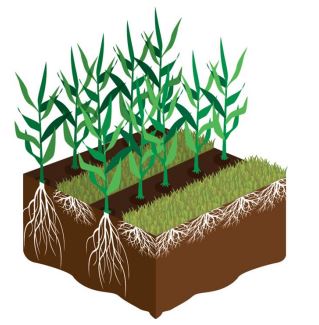Background
Traditional corn-soybean rotations typical of the midwest leave much of the landscape bare for a portion of the year. This bare land lacks plant life and root mass, leaving soil vulnerable to erosion from rainfall and resulting in nitrogen export through leaching and runoff. Traditional cover crop approaches are utilized to help mitigate these issues, providing soil coverage for an extended period of time when the cash crop is not growing. Cover crop use can have several benefits, such as increased soil health, increased yields, weed suppression, attracting pollinators, and reducing nutrient losses. However, cover crops systems add additional cost and complexity to a farm operation, and as a result, cover cropping is only practiced at rates of 4% of US agricultural land.
Perennial Groundcover
A Perennial groundcover (PGC) system is a proposed cover cropping approach in which a compatible perennial groundcover is grown simultaneously with the cash crop and provides year-round soil coverage in agricultural fields. PGC may provide the ecosystem services of conventional cover cropping without the added cost, labor, and management complexity because the PGC would not need to be planted annually.
The goal of this INRC research project in Nashua is to understand the impact of a perennial groundcover system on nitrogen loss in a continuous corn system. We are measuring impacts on water quailty and also monitoring several soil characteristics, including moisture content, aggregate stability, infiltration rate, and pentetration resistance. We are utilizing Kentucky Bluegrass (a common lawn grass) as our PGC. 